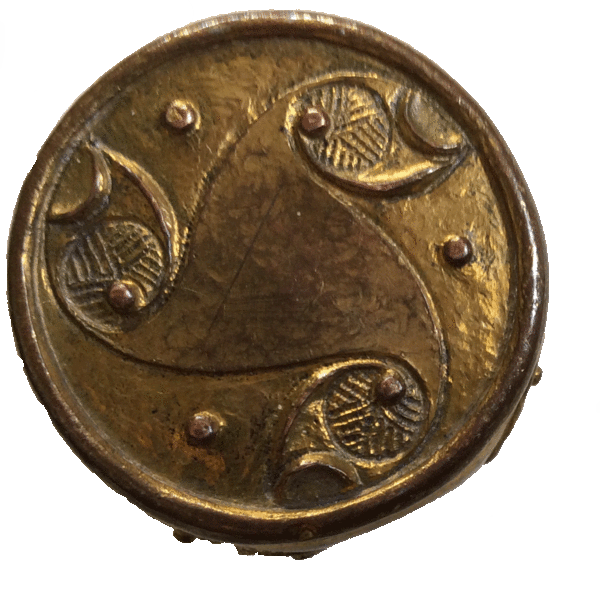CDAS visit to St Quiricus and St Julietta church Tickenham, 14th July 2022
On a sunny and hot evening, 20 CDAS members and friends visited the church at Tickenham. Bob, our guide gave us an interesting tour and we were given a welcome cup of tea or coffee plus a biscuits in the church's servery.
The Dedication
The unusual dedication refers to a mother and her 3 year old child (in some versions they are not related). Julietta was being questioned and tortured about her Christian faith in Tarsus in 304AD (during the persecution of Christians by the Emperor Diocletian) by the Roman Governor Alexander. Her son Quiricus was being held on Alexander's knee and in his struggle to reach his mother Quiricus scratched Alexander's face who then throw him down some stone steps killing him. Julietta rejoiced that her son had been martyred for their faith. She was tortured and finally beheaded. The bodies were thrown on to a pile of corpses of criminals outside the city. They were retrieved by two maidservants who gave them a proper burial.
Under the Emperor Constantine, the Roman Empire became Christian and the maidservants revealed where the graves were and they became a place of pilgrimage.There are many churches on the Continent dedicated to the Saints and a few in Britain ( Newton St Cyres in Devon, Swaffam Prior in Cambridgeshire, Luxulyan and St Veep in Cornwall). Why Tickenham has this unusual dedication is a mystery. The church tower has statues relating to the story.
The Church
There may have been an earlier wooden church on the site. It appears that the first stone church consisted of a narrow and high nave, similar to the Saxon church at Bradford on Avon, and a chancel linked by a low round arch. Arches were cut through the walls in the 13th Century when the North and South Aisles and the Lady Chapel were added . The South Aisle probably was divided up into chapels for local dignitaries. The windows are from different periods between the 13th and 15th Centuries. The vestry/servery/ meeting room is reached through a door from the North Aisle and was added in 1827. Toilets were added next to the vestry in 2001. Originally the interior would have been plastered and the walls would have been covered in plaques. The plaster and most of the plaques were removed in the Victorian Restoration. The one remaining plaque is to Samuel Bave of Barrow Court.
The North Aisle has 3 stone effigies of members of the Berkeley family who owned the Manor. Bob felt that originally these effigies would have been placed more centrally in the north aisle, with vaults beneath them where the bodies would have been placed.
There are many bosses and corbels with carvings throughout the church.
The altars in the Chancel and Lady Chapel each have Eltonwear columns, crosses and candle sticks donated by Sir Edmond Elton of Clevedon Court in 1895 in memory of his mother. The window over the main altar was destroyed by a bomb exploding nearby in World War II. It was replaced by modern stained glass.
The church contains the tomb of the husband of Eleanor Glanville the 17th Century Entomologist. She lived in Tickenham Court and is the subject of the novel by Fiona Mountain, “Lady of the Butterflies”.
Over the arch between the nave and the chancel there is a door to what would have led to the Rood Loft. The entrance to this has been blocked. There is also a small “squint” window where a child would have been lifted up from the Rood Loft to observe when the Host was being raised up by the priest so that he could then signal to the congregation. Their view would have been blocked by the Rood Screen in front of the arch. Above the arch is the Coat of Arms of Charles II.
The font dates to about 1300, and has a square bowl, a central shaft and 4 slimmer Purbeck Marble shafts. There is a hexagonal Jacobean carved wooded pulpit in the nave.
Some medieval stained glass survives including an unusual Christ Crucified on a green wooden cross and Christ in Majesty. There are also windows relating to the Berkeley family, possibly including a depiction of Berkeley Castle.
The Tower
This started as a low tower of a similar height to the roof but was heightened in the 15th Century.
The spiral staircase to the top of the tower is extremely narrow. The parapet and spirelet were added in the 19th Century.
The Church Yard
There is a Tide Clock (type of sun dial) on the south wall of the church. Nearby there are 2 ancient yew trees, possibly 600 years old.
This visit concluded our program of summer visits for 2022.
Tom Chown, 18.07.2022







